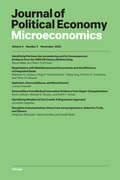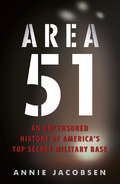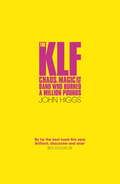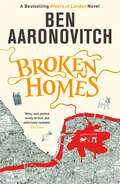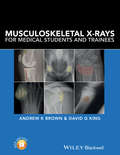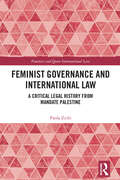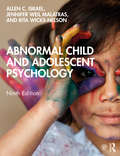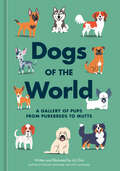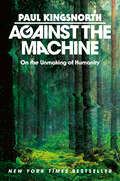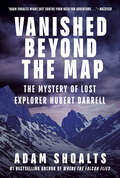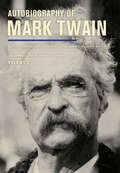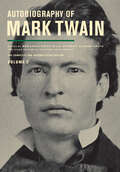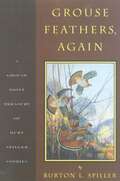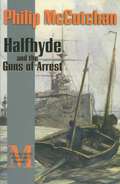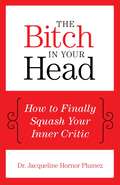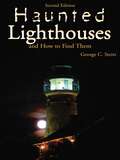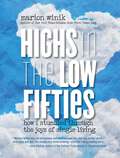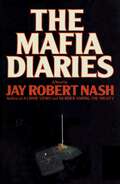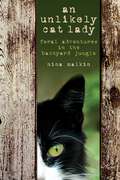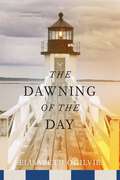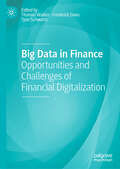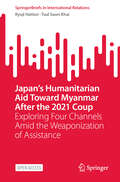- Table View
- List View
Journal of Political Economy Microeconomics, volume 3 number 4 (November 2025)
by Journal of Political Economy MicroeconomicsThis is volume 3 issue 4 of Journal of Political Economy Microeconomics. Journal of Political Economy Microeconomics (JPE Micro) strives to publish high-quality theoretical, empirical, and econometric research papers and replication studies that address issues of relevance to microeconomics. Microeconomics is interpreted in the broadest possible sense and includes issues related to how individuals, households, firms, and governments make choices, and how those choices affect prices, the allocation of resources, and the well-being of people. JPE Micro welcomes submissions in all areas of microeconomics including, but not limited to, industrial organization and labor, behavioral, experimental, environmental, international, public, health care, education, and development economics.
Area 51: An Uncensored History of America's Top Secret Military Base
by Annie JacobsenThe explosive, untold story of the Cold War's biggest secret from the bestselling author of NUCLEAR WAR: A SCENARIO'An extraordinary book' DAILY EXPRESS'Revelatory . . . the research is compellingly hard-hitting' NEW YORK TIMESIt is the most famous military installation in the world. And no credible insider has ever divulged the truth about his time inside of it. Until now. This is the first book based on interviews with scientists, pilots, and engineers - 58 in total - who provide an unprecedented look into the mysterious activities of a top-secret base, from the Cold War to today. With a jaw-dropping ending, it proves that facts are often more fantastic than fiction, especially when the distinction is almost impossible to make.
The KLF: Chaos, Magic and the Band who Burned a Million Pounds
by John Higgs'The best non-fiction book I've ever read. It's magical. Stunning' Dan Schreiber, No Such Thing As a Fish'A pop biography for people who don't read pop biographies' Dorian Lynskey, Guardian'Brilliant, discursive and wise' Ben Goldacre'Utterly irresistible and totally brilliant' The Quietus'A thing of endlessly fascinating, utterly demented genius' Alexis PetridisTHE STRANGE TALE OF THE DEATH, LIFE AND LEGACY OF THE HUGELY SUCCESSFUL BAND.They were the bestselling singles band in the world. They had awards, credibility, commercial success and creative freedom. Then they deleted their records, erased themselves from musical history and burnt their last million pounds in a boathouse on the Isle of Jura. And they couldn't say why.This is not just the story of The KLF. It is a book about Carl Jung, Alan Moore, Robert Anton Wilson, Ken Campbell, Dada, Situationism, Discordianism, magic, chaos, punk, rave, the alchemical symbolism of Doctor Who and the special power of the number 23.Wildly unauthorised and unlike any other music biography, THE KLF is a trawl through chaos on the trail of a beautiful, accidental mythology.
Broken Homes: Book 4 in the #1 bestselling Rivers of London series (A Rivers of London novel #4)
by Ben AaronovitchBook 4 in the Rivers of London series, from Sunday Times Number One bestselling author Ben Aaronovitch.A mutilated body in Crawley. Another killer on the loose. The prime suspect is one Robert Weil - an associate of the twisted magician known as the Faceless Man? Or just a common garden serial killer? Before PC Peter Grant can get his head round the case, a town planner going under a tube train and a stolen grimoire are adding to his case-load. So far so London. But then Peter gets word of something very odd happening in Elephant and Castle, on an housing estate designed by a nutter, built by charlatans and inhabited by the truly desperate. Is there a connection? And if there is, why oh why did it have to be South of the River?Praise for the Rivers of London novels:'Ben Aaronovitch has created a wonderful world full of mystery, magic and fantastic characters. I love being there more than the real London'NICK FROST'As brilliant and funny as ever'THE SUN'Charming, witty, exciting'THE INDEPENDENT'An incredibly fast-moving magical joyride for grown-ups'THE TIMESDiscover why this incredible series has sold over two million copies around the world. If you're a fan of Terry Pratchett or Douglas Adams - don't panic - you will love Ben Aaronovitch's imaginative, irreverent and all-round irresistible novels.
Musculoskeletal X-Rays for Medical Students and Trainees
by Andrew K. Brown David G. KingMusculoskeletal X-rays for Medical Students provides the key principles and skills needed for the assessment of normal and abnormal musculoskeletal radiographs. With a focus on concise information and clear visual presentation, it uses a unique colour overlay system to clearly present abnormalities. Musculoskeletal X-rays for Medical Students: Presents each radiograph twice, side by side – once as would be seen in a clinical setting and again with clearly highlighted anatomy or pathology Focuses on radiographic appearances and abnormalities seen in common clinical presentations, highlighting key learning points relevant to each condition Covers introductory principles, normal anatomy and common pathologies, in addition to disease-specific sections covering adult and paediatric practice Includes self-assessment to test knowledge and presentation techniques Musculoskeletal X-rays for Medical Students is designed for medical students, junior doctors, nurses and radiographers, and is ideal for both study and clinical reference.
Feminist Governance and International Law: A Critical Legal History from Mandate Palestine (Feminist and Queer International Law)
by Paola ZichiDocumenting the intertwined history of international institutions and transnational feminism through the lens of Mandate Palestine in the inter-war period, this book elicits the historical formation of an early form of feminist governance at the international level. It is commonly accepted that ‘International Women’s Rights’ entered the halls of international institutions with the 1979 passage of the Convention on the Elimination of Discrimination Against Women. But as this book argues, feminist interventions in international law began much earlier. Engaging the history of feminist engagements with the first international institution of modern international law, the League of Nations, this book – based on archival research and drawing upon TWAIL and critical legal feminist approaches – focuses on the Arab-Palestinian feminist movement. Uncovering a peripheral feminist legal agenda, driven by women under colonial rule, the book interrogates feminist legal advances in three different fields: criminal and anti-trafficking laws, family and divorce laws, and human rights and prisoners’ laws. Detailing this early feminist legal activism, the book demonstrates how today’s feminists’ mission, as enshrined in the UN Charter and subsequent conventions, are the by-product of a much longer history of colonial resistance and contestation. This book will be of considerable interest to scholars and researchers in the fields of international law, international history, women’s and feminist history, and feminist legal studies.
Abnormal Child and Adolescent Psychology
by Rita Wicks-Nelson Allen C. Israel Jennifer Weil MalatrasAbnormal Child and Adolescent Psychology is a comprehensive introduction to the field. It covers theoretical and methodological foundations and examines the characteristics, epidemiology, etiology, developmental course, assessment, and treatment of disorders of childhood and adolescence. At the heart of the text is the partnership of the developmental psychopathology perspective, which analyzes problems of youth within a developmental context, and a traditional clinical/disorder approach, which underscores the symptoms, causes, and treatments of disorders. Woven throughout the text is the view that behavior stems from the continuous interaction of multiple influences, that the problems of the young are intricately tied to their social and cultural contexts, and that empirical approaches and the scientific method provide the best avenue for understanding the complexity of human behavior.This edition explores the latest areas of research and tackles important contemporary topics, including: how to best classify and diagnose problems the Research Domain Criteria (RDoC) framework the roles of genetics and early brain development and their interaction with the environment the complex roles of family and peers; sex/gender; and culture, ethnicity, and race in psychopathology progress in early intervention and prevention improvements in accessibility and dissemination of evidence-based treatments social issues such as poverty, child maltreatment, substance use, bullying/victimization, and terrorism and war This edition also features a new full-color design and over 200 color figures, tables, and photos. The text is written in a clear and engaging style and is approachable for students with varying academic backgrounds and experiences. It is rich in case descriptions that allow students to examine problems through the lens of youth and their families. The "Accent" boxes foster discussion of current interest topics such as infant mental health, scientific evidence regarding vaccines and autism, suicidality in sexual minority youth, and the impact of stigmatization. The "Looking Forward" sections focus students’ attention on the central concepts to be addressed, while the "Looking Back" sections provide students with a synopsis of the chapter for further study and reflection. The text is also supplemented with online resources for students and instructors.
Dogs of the World: A Gallery of Pups from Purebreds to Mutts [A Dog Breed Book]
by Lili ChinFrom the noble Afghan to indigenous village dogs, this vibrant illustrated gallery offers fascinating information on more than 600 dog breeds, from the author and illustrator of Doggie Language and Kitty Language.Meet more than 600 types of dogs in this captivating canine gallery, from the English Springer Spaniel and Moroccan Aïdi to the Thai Ridgeback and the New Guinea Singing Dog. Packed with fascinating tidbits and hundreds of illustrations, Dogs of the World also shines a welcome spotlight on the world&’s 85 percent of dogs who are no breed at all, including mutts and village dogs.You&’ll learn about different dog types and their working roles, such as herding, livestock guarding, scent detection, dog sports, and companionship, and understand what terms like purebred and landrace mean. Trace the history of our modern dogs through a vibrantly visual timeline, and pick up insights on breed health risks, personality traits, and how breed ancestry DNA tests work.Featuring adorable artwork and research vetted by dog history experts, behavior professionals, and veterinarians, this is a loving and accessible guide to the diversity of our canine companions.
Against the Machine: On the Unmaking of Humanity
by Paul KingsnorthHow a force that&’s hard to name, but which we all feel, is reshaping what it means to be humanIn Against the Machine, &“furiously gifted&” (The Washington Post) novelist, poet, and essayist Paul Kingsnorth presents a wholly original—and terrifying—account of the technological-cultural matrix enveloping all of us. With masterful insight into the spiritual and economic roots of techno-capitalism, Kingsnorth reveals how the Machine, in the name of progress, has choked Western civilization, is destroying the Earth itself, and is reshaping us in its image. From the First Industrial Revolution to the rise of artificial intelligence, he shows how the hollowing out of humanity has been a long game—and how your very soul is at stake.It takes effort to remain truly human in the age of the Machine. Writing in the tradition of Wendell Berry, Jacques Ellul and Simone Weil, Kingsnorth reminds us what humanity requires: a healthy suspicion of entrenched power; connection to land, nature and heritage; and a deep attention to matters of the spirit. Prophetic, poetic, and erudite, Against the Machine is the spiritual manual for dissidents in the technological age.
Vanished Beyond the Map: The Mystery of Lost Explorer Hubert Darrell
by Adam ShoaltsCanada&’s greatest modern-day explorer sets out into the arctic wilderness to solve a mystery more than 100 years old.In November 1910, explorer Hubert Darrell vanished in the uncharted wilds of the Northwest Territories. A prospector who had been swept up in the Klondike Gold Rush, Darrell later made his name as an expert guide, trapper, and restless wanderer who ventured where few others dared. At a time when travel by dogsled in the North was the norm, Darrell became legendary for traversing thousands of kilometres alone and on foot; ranging over mountains and across windswept tundra from Alaska to Hudson Bay. During his epic journeys, he helped rescue sailors trapped in sea ice, led Mounties on their patrols, and even guided some of the era&’s most famous explorers. Roald Amundsen, the first person to reach the South Pole, held Darrell in awe, remarking once that with men like him, he could go to the moon. Contemporaries regarded Darrell as the hardiest, most competent explorer of his day. Despite clues reported by Inuit trappers and Mounted Police inquiries, his fate remains a mystery. While his disappearance sparked headlines around the world, Darrell&’s name would soon also vanish from the history books, ironically, just as surely as he had in the wild.Yet Darrell left behind a trail of letters, journals, and hand-drawn maps. With these faded clues and his zeal for adventure, Adam Shoalts retraces Darrell&’s forgotten routes through the wilderness, searching for cabin ruins and old campsites. He unearths water-stained records and tracks down elderly individuals in the hopes that they might remember someone who&’d known Darrell. Part detective story, part biography, and part first-person adventure narrative, Vanished Beyond the Map combines expeditions with historical research to solve one of exploration history&’s enduring cold cases—the mystery of Hubert Darrell.
The Art of Language Invention: From Horse-Lords to Dark Elves to Sand Worms, the Words Behind World-Building
by David J. PetersonAn insider&’s tour through the construction of invented languages from the bestselling author and creator of languages for Legendary's Dune, the HBO series Game of Thrones and the Syfy series DefianceFrom master language creator David J. Peterson comes a creative guide to language construction for sci-fi and fantasy fans, writers, game creators, and language lovers. Peterson offers a captivating overview of language creation, covering its history from Tolkien&’s creations and Klingon to today&’s thriving global community of conlangers. He provides the essential tools necessary for inventing and evolving new languages, using examples from a variety of languages including his own creations, punctuated with references to everything from Star Wars to Janelle Monáe. Along the way, behind-the-scenes stories lift the curtain on how he built languages like Dothraki for HBO&’s Game of Thrones and Shiväisith for Marvel&’s Thor: The Dark World, and an included phrasebook will start fans speaking Peterson&’s constructed languages. The Art of Language Invention is an inside look at a fascinating culture and an engaging entry into a flourishing art form—and it might be the most fun you&’ll ever have with linguistics.The Art of Language Invention includes a new chapter on phrases, specifically, word order, negation, question formation, pragmatic concerns, relativization, and subordination, providing a complete introduction to language creation and linguistics. Invented languages featured in the book now include Chakobsa from Legendary&’s Dune, Trigedasleng (or Grounder) from The 100, Méníshè language from Motherland: Fort Salem and Ravkan from the Netflix series Shadow and Bone.
Autobiography of Mark Twain, Volume 3: The Complete and Authoritative Edition (Mark Twain Papers)
by Mark TwainMark Twain's final and uncensored masterpiece, presented in three volumes, is a landmark publication in American literature."Twain will begin to seem strange again, alluring and still astonishing . . . in ways that still resonate with us."—New York Times "His crystalline humor and expansive range are a continuous source of delight and awe."—Los Angeles Times Book Review When the first volume of Mark Twain’s uncensored Autobiography was published in 2010, it was hailed as an essential addition to the shelf of his works and a crucial document for our understanding of the great humorist’s life and times. This third and final volume crowns and completes his life’s work. Like its companion volumes, it chronicles Twain's inner and outer life through a series of daily dictations that go wherever his fancy leads. Created from March 1907 to December 1909, these dictations present Mark Twain at the end of his life: receiving an honorary degree from Oxford University; railing against Theodore Roosevelt; founding numerous clubs; incredulous at an exhibition of the Holy Grail; credulous about the authorship of Shakespeare’s plays; relaxing in Bermuda; observing (and investing in) new technologies. The Autobiography’s "Closing Words" movingly commemorate his daughter Jean, who died on Christmas Eve 1909. Also included in this volume is the previously unpublished "Ashcroft-Lyon Manuscript," Mark Twain’s caustic indictment of his "putrescent pair" of secretaries and the havoc that erupted in his house during their residency. Fitfully published in fragments at intervals throughout the twentieth century, Autobiography of Mark Twain has now been critically reconstructed and made available as it was intended to be read. Fully annotated by the editors of the Mark Twain Project, the complete Autobiography emerges as a landmark publication in American literature. Editors: Benjamin Griffin and Harriet Elinor Smith Associate Editors: Victor Fischer, Michael B. Frank, Amanda Gagel, Sharon K. Goetz, Leslie Diane Myrick, Christopher M. Ohge
Autobiography of Mark Twain, Volume 2: The Complete and Authoritative Edition (Mark Twain Papers)
by Mark TwainMark Twain's final and uncensored masterpiece, presented in three volumes, is a landmark publication in American literature."Twain will begin to seem strange again, alluring and still astonishing . . . in ways that still resonate with us."—New York Times "His crystalline humor and expansive range are a continuous source of delight and awe."—Los Angeles Times Book Review Mark Twain’s complete, uncensored Autobiography was an instant bestseller when the first volume was published in 2010, on the centennial of the author’s death, as he requested. Published to rave reviews, the Autobiography was hailed as the capstone of Twain’s career. It captures his authentic and unsuppressed voice, speaking clearly from the grave and brimming with humor, ideas, and opinions. The eagerly-awaited Volume 2 delves deeper into Mark Twain’s life, uncovering the many roles he played in his private and public worlds. Filled with his characteristic blend of humor and ire, the narrative ranges effortlessly across the contemporary scene. He shares his views on writing and speaking, his preoccupation with money, and his contempt for the politics and politicians of his day. Affectionate and scathing by turns, his intractable curiosity and candor are everywhere on view. Editors: Benjamin Griffin and Harriet E. Smith Associate Editors: Victor Fischer, Michael B. Frank, Sharon K. Goetz and Leslie Diane Myrick
All Her Fault: Soon to be a major TV series starring Sarah Snook, a gripping psychological thriller from the Sunday Times bestselling author of No One Saw a Thing
by Andrea Mara*Soon to be a major TV series starring Sarah Snook*'A heart-stopping tale . . . Stunningly original' Sunday Times Crime Book of the Month'Grips from the first page and keeps upping the stakes.' Sarah Pearse, bestselling author of The SanatoriumONE MISSING BOY.Marissa Irvine arrives at 14 Tudor Grove, expecting to pick up her young son Milo from his first playdate with a boy at his new school. But the woman who answers the door isn't a mother she recognises. She isn't the nanny. She doesn't have Milo. And so begins every parent's worst nightmare.FOUR GUILTY WOMEN.As news of the disappearance filters through the quiet Dublin suburb and an unexpected suspect is named, whispers start to spread about the women most closely connected to the shocking event. Because only one of them may have taken Milo - but they could all be blamed . . .IN A COMMUNITY FULL OF SECRETS, WHO IS REALLY AT FAULT?'Sharp, sophisticated, and full of suspense - everything you need for a perfect summer read.' Cara Hunter, bestselling author of Close to Home'Andrea Mara's tight plotting and convincing characterisation make her books both compelling and intriguing.' Liz Nugent, author of Lying in Wait'A wonderfully twisty nightmare of a domestic thriller.' Emma Curtis, author of Keep Her Quiet'A cracking read from a writer at the top of her game - and wow . . . that twist floored me!' Claire Allan, author of Her Name Was Rose'Someone has taken Marissa's child; the fun in this fiendishly twisting narrative is trying to work out who that might be.' Irish IndependentEveryone is gossiping about All Her Fault:'WOW WOW WOW! I have not read a book this thrilling in ages' * * * * *'So many twists and turns, and what a shock at the end' * * * * *'This is one of the best thriller books I have read this year . . . I was totally blown away' * * * * *'You must read this book' * * * * *'The final chapter is the perfect payoff' * * * * *'A great twisty read that kept me on the edge of my seat' * * * * *Don't miss Andrea Mara's unputdownable new novel, Such a Nice Girl - available to pre-order now!
Grouse Feathers, Again: The Grouse Point Almanac Presents The Spiller Treasury
by Burton SpillerBurton Spiller's Grouse Feathers is without question the best known book of all time on grouse hunting. His stories have been read and loved since their original publication by The Derrydale Press in 1935. Now, The Derrydale Press is proud to present a new collection of Spiller's stories that have not been previously published in any book.
Halfhyde and the Guns of Arrest
by Philip McCutchanRoyal Navy Lieutenant St. Vincent Halfhyde is once again dispatched to Africa. This time, his mission is to help capture a British traitor who carries secret blueprints of British warships. Assisted by a Scotland Yard detective and a handful of sailors, Halfhyde must outwit the clever Germans, who are determined to take the traitor and his secrets back to the Fatherland.
The Bitch in Your Head: How to Finally Squash Your Inner Critic
by Jacqueline Hornor PlumezDo you ever find yourself thinking, how could you be so stupid, you look fat, or you&’re a horrible mother? Are you afraid people will find out you&’ve fooled them into thinking you're competent? If you&’re guilty of expressing these types of discouraging messages, then you have a bitch in your head. This self-critical behavior can wreak havoc with your life—it can keep you from getting the love you want, the raise you deserve, or even a good night&’s sleep.Dr. Plumez began to notice a pattern with her patients being too hard on themselves. She found that gentler approaches didn&’t work, but when she told them they were being a bitch—to themselves!—they finally recognized their self-defeating attitude and how much it was weighing them down.With this book, Dr. Plumez can help you banish the bitch. It identifies the different types of &“bitches&”—work, marriage, parenting, and so on—and provides effective tools and techniques to combat the forms of self-destruction described. Once you begin to encourage rather than criticize, you will find that your career, social life, and relationships almost magically improve.
Haunted Lighthouses
by George SteitzThis updated edition has four new haunted lighthouses.Lighthouses are America's castles—proud, sturdy, mystical, and sometimes even haunted. The producer of the popular television series Haunted Lighthouses, seen on the Discovery Channel, the Learning Channel, and the Travel Channel, takes you on a tour of the legends of these bewitching monuments as he films. Meet a cast of intriguing characters including noted historians, people who work in lighthouses, and even the ghosts themselves. You will also learn helpful travel tips including the best places to stay and dine, things to do, and must-see attractions.
Highs in the Low Fifties: How I Stumbled Through The Joys Of Single Living
by Marion WinikA cross between Nora Ephron and David Sedaris, longtime NPR commentator Marion Winik has a uniquely hilarious and relatable way of looking at life. Her stories of being single in middle age, marked by stylish writing and stunning candor, left readers bent double with laughter when they appeared in her column, rated "Best of Baltimore" by Baltimore Magazine.Highs in the Low Fifties follows Winik’s attempt to rebuild her world as a once-widowed, once-divorced single mom. With her signature optimism, resilience, and poor judgment, Winik dives into a series of ill-starred romantic experiences. Her clarity about her mistakes and ability to find humor in the darkest moments—in love, and in all parts of life—has won her a growing crowd of devoted followers . . . and a few voyeurs.
The Mafia Diaries
by Jay Robert NashBrilliant crime historian and reluctant sleuth Jack Journey finds himself once again entangled with the criminal element as he takes on a search for the diaries of a long-dead Sicilian bandit that might hold the key to unraveling a huge network of organized crime.First, a rare-book dealer from whom Journey has arranged to buy an old and valuable collection is found in his loft gruesomely stabbed with a billing spike. Missing is a priceless encyclopedia. Next, a man the killers ,istake for Journey is horribly burned to death in an outdoor market. And then the detective meets darkly exotic Laura Manville—beautiful and seductive—who enters Journey's life like a harbinger of disaster. After leaving his native Chicago to hunt for the killers in New York, he moves on to the treacherous underworld of PAris when clues lead to Europe. There, with growing horror, Journey begins to uncover a chilling link between the recent killings and a mysterious murder almost forty years before.
Washington Off the Beaten Path®: Discover Your Fun (Off the Beaten Path Series)
by Megan HillWashington Off the Beaten Path features the things travelers and locals want to see and experience––if only they knew about them. From the best in local dining to quirky cultural tidbits to hidden attractions, unique finds, and unusual locales, Washington Off the Beaten Path takes the reader down the road less traveled and reveals a side of Washington that other guidebooks just don't offer.
Unlikely Cat Lady: Feral Adventures In The Backyard Jungle
by Nina MalkinA Brooklyn woman who &“has it all&” gets a lot more than she bargained for when a family of wild cats moves into her backyard. This hilarious and heartwarming memoir follows author Nina Malkin&’s obsessive attempts to serve, protect, and befriend the feral colony as she reluctantly comes to terms with being a &“crazy cat lady.&” Packed with insights and information on feline behavior and the nuts and bolts of cat caretaking, this book brings the feral cat epidemic home in all-too human terms.
The Dawning of the Day
by Elisabeth OgilviePhilippa Marshall arrives on isolated Bennett&’s Island as a young war widow eager to provide for her son. The insular island community initially welcomes her as the teacher in their one-room schoolhouse, but when she champions a clutch of neglected children, she finds herself thrust in the midst of a smoldering conflict between two prominent families. The prospect of a lobster war between the Bennetts and Campions threatens the livelihoods of everyone who calls Bennett&’s Island home. Philippa must grapple with her sense of loyalty to her deceased husband, even as her feelings for Steve Bennett blossom against the rugged coastal landscape. She longs to be reunited with her son, but she&’s troubled by the specter of latent strife that lies beneath the tranquil surface of the island community. Philippa must weigh the balance of her heart and her mind and plot the course of her destiny.
Big Data in Finance: Opportunities and Challenges of Financial Digitalization
by Thomas Walker Tyler Schwartz Frederick DavisThis edited book explores the unique risks, opportunities, challenges, and societal implications associated with big data developments within the field of finance. While the general use of big data has been the subject of frequent discussions, this book will take a more focused look at big data applications in the financial sector. With contributions from researchers, practitioners, and entrepreneurs involved at the forefront of big data in finance, the book discusses technological and business-inspired breakthroughs in the field. The contributions offer technical insights into the different applications presented and highlight how these new developments may impact and contribute to the evolution of the financial sector. Additionally, the book presents several case studies that examine practical applications of big data in finance. In exploring the readiness of financial institutions to adapt to new developments in the big data/artificial intelligence space and assessing different implementation strategies and policy solutions, the book will be of interest to academics, practitioners, and regulators who work in this field.
Japan’s Humanitarian Aid Toward Myanmar After the 2021 Coup: Exploring Four Channels Amid the Weaponization of Assistance (SpringerBriefs in International Relations)
by Ryuji Hattori Tual Sawn KhaiThis open access book delves into Japan's humanitarian aid efforts in Myanmar following the military coup of February 2021. As Myanmar faces political upheaval and growing humanitarian challenges, Japan's response has been notable, yet intricate, maneuvering through obstacles created by the Myanmar military's weaponization of aid. Utilizing document analysis, semi-structured interviews, and fieldwork conducted at the Myanmar-Thailand border, this book explores four key channels through which Japan delivers humanitarian assistance: UN organizations, Myanmar-based NGOs, Thailand-based NGOs, and Bangladesh-based NGOs. Each channel is examined in detail, highlighting the strategies employed, obstacles faced, and impact of Japan&’s contributions on the ground. This study illuminates the precarious equilibrium between delivering crucial aid and addressing the political circumstances that hinder humanitarian endeavors. It also prompts important discussions about the morality of providing assistance in conflict-ridden areas and the responsibilities of donor nations in upholding their human rights. This book is ideal for academics, decision-makers, and humanitarian professionals, and not only enlightens readers about Japan's distinctive position in Myanmar, but also contributes to wider debates on international aid dynamics in politically fraught environments.
